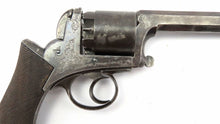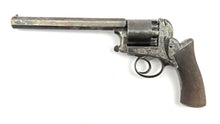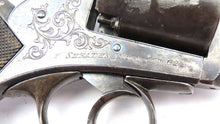
A Very Rare Sheath Patent Revolver. 14” overall, 7 ½” octagonal sighted 38 bore rifled barrel, engraved around the muzzle & faintly engraved ‘B Cogswell of 224 The Strand, London’ along the top flat, retained by a wing headed screw in front of the frame, London proof marks. Self cocking, single action, with plain five shot cylinder, border engraved frame decorated with foliate scrollwork and ‘Sheath’s No. 62’ on the right side, foliate scroll engraved trigger guard & chequered figured rounded butt.
Circa 1853
In worn condition, some pitting, but some original finish but cap replaced
This revolver, one of only two 38 bore that are thought to survive, & the only one with a 7 ½” barrel, fewer than ten in all calibres known.
Made to Sheath’s British Patent No. 966 of 26 April 1853. Taylerson et al notes “Under this patent, a method for attaching a revolver barrel to the frame, by screws, was claimed, together with a use of a projection on the pawl of a self-cocking lock-mechanism, to serve as a cylinder-bolt, by intercepting the nipple-partitions”
Sheath came quite late to the revolver race but his design was considered quite old fashioned even when launched. Despite open frame offerings persevering from the workshops of Colt, solid frame designs were already being considered superior and models from Adams, Tranter and of course Webley soon came to dominate the English made revolver market
See A.W.F. Taylerson, R.A.N. Andrews and J. Frith, The Revolver 1818-1865, 1968, pp. 300-301.













